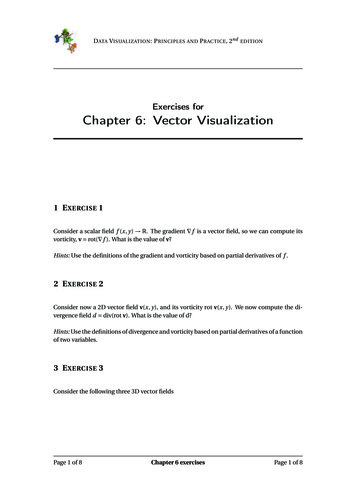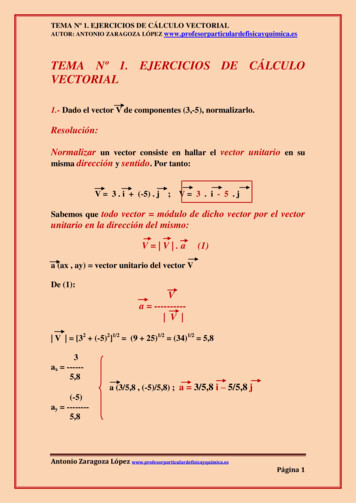
Transcription
D ATA V ISUALIZATION : P RINCIPLES AND P RACTICE , 2ndEDITIONExercises forChapter 6: Vector Visualization1 E XERCISE 1Consider a scalar field f (x, y) R. The gradient f is a vector field, so we can compute itsvorticity, v rot( f ). What is the value of v?Hints: Use the definitions of the gradient and vorticity based on partial derivatives of f .2 E XERCISE 2Consider now a 2D vector field v(x, y), and its vorticity rot v(x, y). We now compute the divergence field d div(rot v). What is the value of d?Hints: Use the definitions of divergence and vorticity based on partial derivatives of a functionof two variables.3 E XERCISE 3Consider the following three 3D vector fieldsPage 1 of 8Chapter 6 exercisesPage 1 of 8
D ATA V ISUALIZATION : P RINCIPLES AND P RACTICE , 2ndEDITIONv1 (x, y, z) ( y, x, 0)(3.1)v2 (x, y, z) (y, x, 0)(3.2)v3 (x, y, z) (3x, 3y, 0)(3.3)Plot these three vector fields using hedgehog glyphs (oriented arrows) for a square domaincentered at the origin and embedded in the x y plane.4 E XERCISE 4Consider the following three 3D vector fields (the same ones as for Exercise 3):v1 (x, y, z) ( y, x, 0)(4.1)v2 (x, y, z) (y, x, 0)(4.2)v3 (x, y, z) (3x, 3y, 0)(4.3)Which of these three fields has a zero curl? Which has a zero divergence? Argue your answerby computing the actual divergence and curl values.5 E XERCISE 5Vector field visualization is considered to be, in general, a more challenging problem thanscalar visualization. Indeed, intuitively speaking, for a sampled dataset of, say, N points, ascalar field would have N values, whereas a (3D) vector field would have 3N values to show.Consider now the case of visualizing a scalar field with N samples vs visualizing a 3D vectorfield with N /3 samples. Both fields need to store the same amount of data values, i.e., N .Which of the following assertions do you support for this situation: Visualizing both fields is, in general, equally challenging Visualizing the vector field is, in general, more challenging than visualizing the vectorfield.Support your answer with a detailed explanation.Page 2 of 8Chapter 6 exercisesPage 2 of 8
D ATA V ISUALIZATION : P RINCIPLES AND P RACTICE , 2ndEDITION6 E XERCISE 6Consider a smooth 2D scalar field f (x, y), and its gradient f , which is a 2D vector field. Consider now that we are densely seeding the domain of f and trace streamlines in f , upstreamand downstream. Where do such streamlines meet? Can you give an analytic definition ofthese meeting points in terms of values of the scalar field f ?Hints: Consider the direction in which the gradient of a scalar field points.7 E XERCISE 7Consider a smooth 2D scalar field f (x, y), and its gradient f , which is a 2D vector field.Consider now the divergence d div ( f ), also called the Laplacian of f . What is the relationbetween the local extrema (minima and maxima) of f and those of d ? The minima of d are the maxima of f The maxima of d are the minima of f Both the above are true None of the above are trueHints: Consider the relationship between minima and maxima of divergence and so-calledsinks and sources of a vector field.8 E XERCISE 8Can any 2D vector field v(x, y) be seen as the gradient of some scalar field f (x, y)? That is:Given any vector field v, can we find a scalar field f , so that v(x, y) f (x, y), for all points(x, y)? If so, argue why, and show how we construct f from v. If not, show and discuss acounter-example.Hints: Consider the vector calculus identities involving curl and gradient.Page 3 of 8Chapter 6 exercisesPage 3 of 8
D ATA V ISUALIZATION : P RINCIPLES AND P RACTICE , 2ndEDITION9 E XERCISE 9Intuitively, we can think of the (mean) curvature of an oriented 3D surface as a scalar function, defined on the surface, which takes large positive values where the surface is convex,large negative values where the surface is concave, and is zero where the surface is locallyflat. How can we compute such a scalar curvature function using just the vector-field definedby the surface normals?10 E XERCISE 10Vector glyphs are one of the simplest, and most used, methods for visualizing vector fields.However, careless use of vector glyphs can lead to either visual clutter (too many glyphsdrawn over the same small screen space) or visual subsampling (large areas in the field’s domain which do not contain any vector glyph). Given a 3D vector field which we want to visualize with vector glyphs, describe all parameters that one can control, and how these shouldbe controlled, to reduce both visual clutter and visual subsampling.11 E XERCISE 11Consider the rectangular areas shown in the figure below. All areas have the same aspect ratio(2l , 1.5l ). For each case, we define four 2D vector values v1 , . . . , v4 at the area’s vertices, andvisualize these by the blue vector glyphs. Now, for each area, look at its center (indicatedby a black point). What is the value of the vector field that you perceive there, based onthe surrounding four blue glyphs? Draw a vector glyph at the central point to indicate thedirection and magnitude of your perceived vector.Page 4 of 8Chapter 6 exercisesPage 4 of 8
D ATA V ISUALIZATION : P RINCIPLES AND P RACTICE , 2ndv4 (1,-1)v3 (1,0)EDITIONv4 (2,1)v3 (1,1)1.5la)v2 (-1,1)v1 (1,0)b)v1 (1,0)v2 (0,1)2lv4 (1,1)v4 (2,1)v3 (0,-2)c)v1 (-1,2)v2 (-1,-1)v3 (1,1)d)v1 (0,2)v2 (0,1)What is the vector value you perceive at the center of each area, given the vertex values?12 E XERCISE 12Consider the figure from the previous exercise (shown again below). For each area, computethe value of the vector field at the central black point, assuming that we are using bilinearinterpolation of the four vertex values. Next, draw the resulting interpolated vectors usingvector glyphs at the respective central points. Finally, compare the result with the one of theprevious exercise. Do you see any differences? If so, which ones, and how do you explainthem?Page 5 of 8Chapter 6 exercisesPage 5 of 8
D ATA V ISUALIZATION : P RINCIPLES AND P RACTICE , 2ndv4 (1,-1)v3 (1,0)EDITIONv4 (2,1)v3 (1,1)1.5la)v2 (-1,1)v1 (1,0)b)v1 (1,0)v2 (0,1)2lv4 (1,1)v4 (2,1)v3 (0,-2)c)v1 (-1,2)v2 (-1,-1)v3 (1,1)d)v1 (0,2)v2 (0,1)What is the vector value produced by bilinear interpolation at the areas’ centers, given thevertex values?13 E XERCISE 13Consider the use of a 3D vector-glyph plot for the visualization of a 3D vector field. Eachglyph is drawn as an arrow oriented and scaled by the vector field’s direction and magnituderespectively. Without any additional cues such as interactively changing the viewpoint, itis clearly very hard to perceive the correct orientation of the resulting arrow glyphs in 3D.Propose and describe two visual enhancements (not using interaction) that would make theperception of 3D orientation of the resulting vector glyphs easier from a given viewpoint.14 E XERCISE 14Consider a 2D vector fielddefined over a 2D square domain. At each point p, the vector³ ¡π p c R 2field is v(p) kp ck. Here, c is the center of the square, and R(α) denotes a rotationby α degrees clockwise. We visualize this vector field with a special kind of glyph: At chosensample points p, we draw a square which has two edges parallel to the vector (v)R(β) , whereβ is a small angle of about 20 degrees. A visualization using this technique is shown in theimage below.Page 6 of 8Chapter 6 exercisesPage 6 of 8
D ATA V ISUALIZATION : P RINCIPLES AND P RACTICE , 2ndEDITIONFor this type of vector field and visualization, answer in detail the following questions: What are the streamlines of the vector field looking like? Looking at the figure below, what can you say about the vector field? Describe the vector field as you see it in the figure in a few sentences. Does this visualization accuratelyconvey the vector field? If so, argue why. If not, argue what are the differences betweenthe perceived vector field and the actual one. Which design elements of the glyph (color, shape, size, orientation, other) influencethe strongest the perception of the vector field?What type of vector field do you see depicted by the square glyphs?15 E XERCISE 15Visualizing time-dependent vector fields (either in the 2D or 3D case) is highly challenging. The main problem here is that, apart from the difficulty of showing the direction andmagnitude of a vector field, we have to somehow show how these quantities change in time.One possible way to do this is to highlight spatial regions where these quantities significantlychange at each time moment – that is, to compute a derivative of the vector field over time,Page 7 of 8Chapter 6 exercisesPage 7 of 8
D ATA V ISUALIZATION : P RINCIPLES AND P RACTICE , 2ndEDITIONand to overlay this information atop of an instantaneous vector field visualization generatedby classical methods, such as e.g. vector glyphs, streamlines, or image-based techniques. Inthis context, propose a metric that would intuitively measure the change in time of the direction and/or magnitude of a vector field. Describe your metric analytically, and argue why itwould be a good solution for the above goal of highlighting regions of rapid change.16 E XERCISE 16Simplified visualizations for vector fields reduce the problem of showing the vector data ateach sample point in the field’s domain to the problem of partitioning the domain into a setof regions, so that the field’s variation over any such region can be easily represented by classical techniques such as vector glyphs or streamlines. For this to work, we need to know howto represent the ‘average’ vector field over some given spatial region R of a domain, wherewe know that our vector field has limited variation. Describe two visual representation techniques that can achieve this type of representation.Hints: First, define what is the constraint of the vector field variation over a given region R Next, propose a way to represent the ‘average’ vector field over R, as well as the variation(deviation from the average) of the field over REnd of Exercises forChapter 6: Vector VisualizationPage 8 of 8Chapter 6 exercisesPage 8 of 8
DATA VISUALIZATION: PRINCIPLES AND PRACTICE, 2nd EDITION Exercises for Chapter 6: Vector Visualization 1 EXERCISE 1 Consider a scalar field f (x,y) !R. The gradient rf is a vector field, so we can compute its vorticity, v rot(rf).What is the value of v? Hints: Use the definitions of the gradient and vorticity based on partial derivatives of f. 2 EXERCISE 2 .











